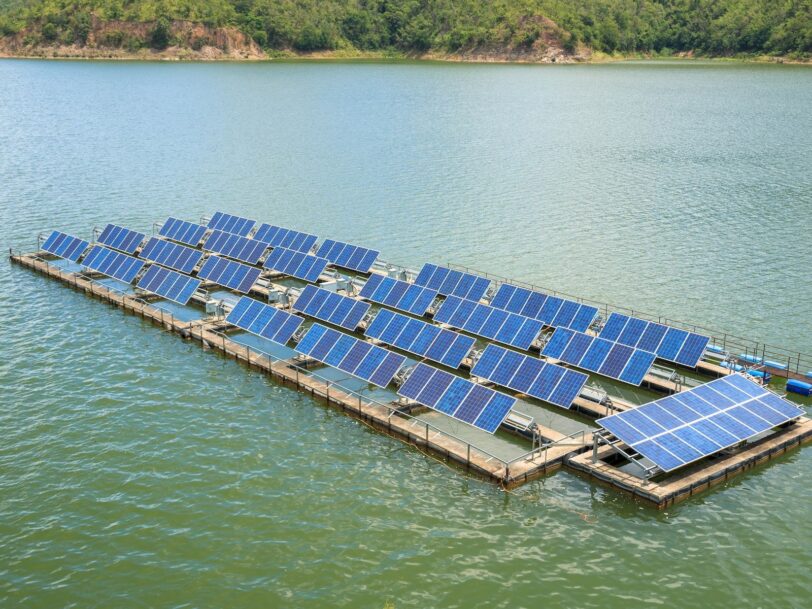What is a floating solar power plant?

Solar energy has become, together with wind power, a basic pillar for the sustainable future to which we aspire as a society. Thanks to solar plates and panels we can take advantage of the energy that comes to us from the greatest source that we have around us, the Sun. Not only that. As we get more efficient panels, we also find better ways to install solar farms. For example, through floating solar panels.
The idea is not new. But it could be developed further. Currently, most solar installations are located on gigantic solar farms that occupy tracts of abandoned land. That in the past perhaps served to cultivate. Solar installations also abound in office buildings and public facilities. But beyond the mainland, there are huge bodies of water where floating solar panels could be installed. Panels that would fulfill two missions instead of one.
And it’s not just an idea. For years, we have found floating solar panel projects in countries with drought problems such as India or with large lakes or rivers such as China, Singapore or Taiwan, countries where the largest floating solar installations in the world are located so far. And there are even studies that support it.
Produce energy and protect water from heat
The most recent study in this regard was published in March in the journal Nature Sustainability. And it is entitled “Energy production and water saving through floating photovoltaic solar energy in global reservoirs”. Among its conclusions, it is estimated that installing floating solar panels in large water reservoirs could generate a third of global electricity. At the same time, it would protect that water from evaporation and help in the fight against the drought that exists in certain regions of the planet.
Obviously, solar panels have a cost. But this has been declining over the years as different technologies and materials emerged. Currently, the efficiency of these panels is greater than those of a decade ago. And they are cheaper to manufacture. A technology that pays for itself in a short time to the point that installation services for solar panels in private homes proliferate.
On the other hand, floating solar panels offer a double service at the same price: generating clean electricity with zero emissions, on the one hand. And on the other hand, protect the water from the heat of the sun. Thus avoiding its evaporation, a problem that can lead to droughts or supply problems.
Thousands of possibilities to explore
The research we are talking about has studied tens of thousands of global water reserves in thousands of communities and dozens of cities and countries. From their database, they have developed a realistic simulation of current photovoltaic technology. And the result is that only by covering a small part of the more than 114,000 global water reserves, thousands of terawatt hours per year would be obtained. And at the same time, the evaporation of 100 cubic kilometers per year would be avoided.
While previous studies were limited to specific countries, this research has been more ambitious and has included global data as well as a model of photovoltaic efficiency in different environmental conditions: temperatures, solar radiation, wind speed… Data from more than two decades.
In addition, the study’s calculations have taken into account the impact of floating solar panels on biodiversity. Hence, the theoretical installation is reduced to 30% of the total area. All in all, the results are promising in terms of power generation. Of course, the benefits of floating solar panels are not the same in all territories. For example, Canada or the Nordic countries would be the least benefited. However, the countries that have the greatest potential in the use of floating solar panels are China, Brazil, India, Canada, Russia, Mexico, Australia, Turkey and South Africa.
Not only that. Of the countries analyzed, 40 of them could cover all their electricity demand using floating solar panels. And if we focus on cities, the list increases to the figure of 150. 150 cities with populations of more than one million people that could meet their electricity needs with floating solar panels.
Floating solar panels for everyone
This study is a great endorsement for the floating solar farm projects that are springing up all over the world. And an incentive for countries that are considering this possibility as a solution to their drought problems and given the need to generate electricity using sustainable methods. Each case is unique, but looking at the research results, there are few reasons not to bet on this type of facility, which can be small or large and can be used both in lakes and rivers, reservoirs and any type of surface with water.
The only drawback to total reliance on solar power is energy storage for hours when there is not enough sun to generate power. A problem that seems to be being resolved as energy storage systems become increasingly larger or capable of storing a greater amount of electricity.